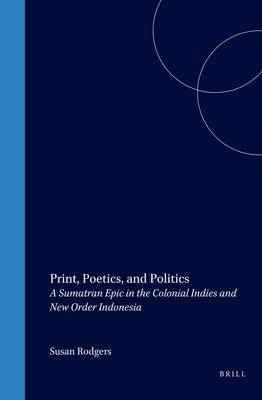
- Afhalen na 1 uur in een winkel met voorraad
- Gratis thuislevering in België vanaf € 30
- Ruim aanbod met 7 miljoen producten
- Afhalen na 1 uur in een winkel met voorraad
- Gratis thuislevering in België vanaf € 30
- Ruim aanbod met 7 miljoen producten
Zoeken
Print, Poetics, and Politics
A Sumatran Epic in the Colonial Indies and New Order Indonesia
S Rodgers
€ 73,45
+ 146 punten
Omschrijving
This study presents the text and first English translation of a Sumatran turi-turian or chanted epic called the tale of Datuk Tuongku Aji Malim Leman, the hero s name. This is a famous southern Batak story from the town of Sipirok. The version at issue, in the Angkola Batak language, was published as a folkloric but also rather novelistic printed paperback book for a popular southern Batak audience in 1941, at the end of Dutch colonial rule in the Indies. This sly book version of Datuk Tuongku by the novelist and newspaperman M.J. Soetan Hasoendoetan, gave southern Batak readers a great literary epic of their own to claim within Indies literatures: here was a touchstone for asserting their cultural excellence at a time when the Batak societies were often denigrated as tribal by both Dutch officialdom and other Indies residents. Soetan Hasoendoetan s deft, elegant, but also playful and funny prose rendition of Datuk Tuongku allowed his Batak readers to imagine Batak traditions and Batak modernities simultaneously, and to mull over the relationships between high oratory and the Latin alphabet print literacy promulgated in the colonial schools of Tapanuli. The study also includes a lengthy anthropological interpretation of the 1941 text, seeing it as a work of both politics and art. The introductory essay draws on postcolonial theory and upon ethnographic fieldwork on literacy, oratory, and turi-turian in Sipirok.
Specificaties
Betrokkenen
- Auteur(s):
- Uitgeverij:
Inhoud
- Aantal bladzijden:
- 333
- Taal:
- Engels
- Reeks:
- Reeksnummer:
- nr. 225
Eigenschappen
- Productcode (EAN):
- 9789067182331
- Verschijningsdatum:
- 1/01/2005
- Uitvoering:
- Paperback
- Formaat:
- Trade paperback (VS)
- Afmetingen:
- 161 mm x 240 mm
- Gewicht:
- 467 g

Alleen bij Standaard Boekhandel
+ 146 punten op je klantenkaart van Standaard Boekhandel
Beoordelingen
We publiceren alleen reviews die voldoen aan de voorwaarden voor reviews. Bekijk onze voorwaarden voor reviews.








